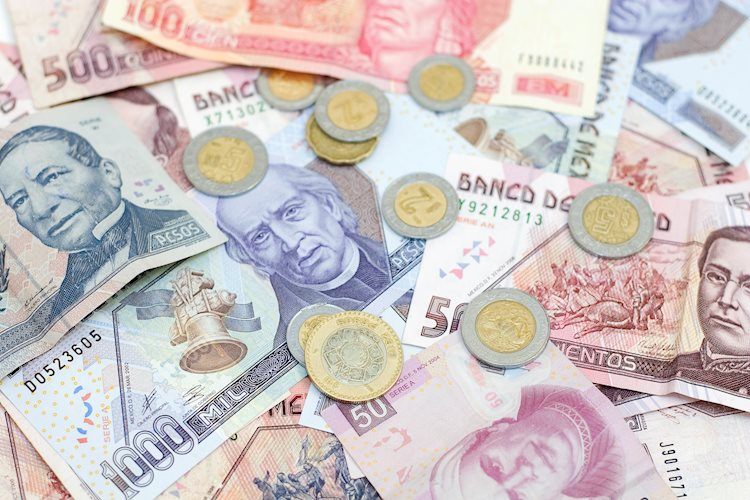- The Mexican Peso modulates between weak gains and losses on Monday.
- The week ahead promises to be busy for traders of the Peso’s key counterparts, given scheduled events and data.
- USD/MXN extends its steady climb within a rising channel.
The Mexican Peso (MXN) seesaws between tepid gains and losses on Monday after falling an average of 1.5% in its major pairs last week. The Bank of Mexico’s (Banxico) decision to cut interest rates by 25 basis points (0.25%) at its September meeting on Thursday, bringing the official cash rate down to 10.50%, as well as a downward revision to its forecasts for the economy, contributed to the Peso’s devaluation across the board.
Data showing a widening trade deficit added to the negativity surrounding the Mexican Peso after official figures showed it widened to $4.868 billion in August from $1.278 billion a year ago. These figures significantly exceeded market expectations of a $0.500 billion gap and reached a new two-year high.
The proximity of the United States (US) election and prospects of former President Donald Trump winning and then imposing an “America First” agenda, with negative implications for trade with Mexico, further add to the concerns regarding Mexico’s persistent trade deficit, which amounts to $10.438 billion for the first eight months of 2024.
Mexican Peso traders prepare for data-heavy week
The Mexican Peso oscillates between mild gains and losses on Monday ahead of a busy week of macroeconomic data releases and key events for its major peers – the US Dollar (USD), Euro (EUR) and Pound Sterling (GBP).
On Monday, speeches by European Central Bank (ECB) President Christine Lagarde and Chairman of the Federal Reserve (Fed) Jerome Powell could impact the EUR and USD, respectively. Recent weak data from the Eurozone, in particular, is leading to speculation in markets that the ECB will have to be more aggressive about cutting interest rates to aid growth, potentially weakening the Euro. In Mexico, Fiscal Balance data for August will be released, revealing the government’s spending shortfall.
On Tuesday, preliminary Eurozone inflation data for September, and then the Nonfarm Payrolls (NFP) on Friday, are further key data releases relating to key Peso pairs. The NFP release will be watched closely for signs of a slowdown in the labor market after the Fed made it clear it is now taking into account its mandate to provide full employment as part of its decision-making on interest rates.
Technical Analysis: USD/MXN trends higher within channel
USD/MXN climbs steadily higher within its rising channel as it continues its short, medium and long-term bullish trend.
USD/MXN Daily Chart
Friday’s close above 19.68 (September 25 high) provided more bullish certainty of the pair’s near-term upside bias towards a target at 20.15, the high of the year reached in early September.
A further break above 19.76 (the September 27 high) would create a higher high and provide yet more proof of an extension of the uptrend.
Mexican Peso FAQs
The Mexican Peso (MXN) is the most traded currency among its Latin American peers. Its value is broadly determined by the performance of the Mexican economy, the country’s central bank’s policy, the amount of foreign investment in the country and even the levels of remittances sent by Mexicans who live abroad, particularly in the United States. Geopolitical trends can also move MXN: for example, the process of nearshoring – or the decision by some firms to relocate manufacturing capacity and supply chains closer to their home countries – is also seen as a catalyst for the Mexican currency as the country is considered a key manufacturing hub in the American continent. Another catalyst for MXN is Oil prices as Mexico is a key exporter of the commodity.
The main objective of Mexico’s central bank, also known as Banxico, is to maintain inflation at low and stable levels (at or close to its target of 3%, the midpoint in a tolerance band of between 2% and 4%). To this end, the bank sets an appropriate level of interest rates. When inflation is too high, Banxico will attempt to tame it by raising interest rates, making it more expensive for households and businesses to borrow money, thus cooling demand and the overall economy. Higher interest rates are generally positive for the Mexican Peso (MXN) as they lead to higher yields, making the country a more attractive place for investors. On the contrary, lower interest rates tend to weaken MXN.
Macroeconomic data releases are key to assess the state of the economy and can have an impact on the Mexican Peso (MXN) valuation. A strong Mexican economy, based on high economic growth, low unemployment and high confidence is good for MXN. Not only does it attract more foreign investment but it may encourage the Bank of Mexico (Banxico) to increase interest rates, particularly if this strength comes together with elevated inflation. However, if economic data is weak, MXN is likely to depreciate.
As an emerging-market currency, the Mexican Peso (MXN) tends to strive during risk-on periods, or when investors perceive that broader market risks are low and thus are eager to engage with investments that carry a higher risk. Conversely, MXN tends to weaken at times of market turbulence or economic uncertainty as investors tend to sell higher-risk assets and flee to the more-stable safe havens.
Read the full article here

